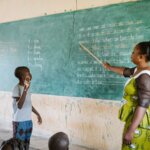- Inclusive Education
Why Inclusive Education? Q & A, tutorial videos, and resources.

Kadidiatou was born without hands. With the help of a rehabilitation worker, she developed her own writing technique and is now able to attend school together with her non-disabled peers. Kadidiatou has become a well-liked, integral part of her social group and spends a lot of time with her classmates. Thanks to inclusive education, her dream of attending high school and studying at a university is moving within her reach.
1. What is inclusive education?
Inclusive education is schooling for the vast majority of children within a mainstream system, where all children – including those with disabilities – are given the opportunity and support to learn together in the same classroom.
2. Why does the world need inclusive education?
Because it is outrageous that more than 32 million children with disabilities in developing countries are out of school. That’s more than three times the entire population of Sweden!
Their ‘disabled status’ has a bigger impact on their chances of receiving an education than their gender, location or household.
Being out of education denies this group the ability to make friends, to learn how to read and write, and to master the skills that are crucial for future employment.
If we do not fight this injustice, we will remain light-years away from the Sustainable Development Goals target to ensure a quality education for all by 2030.
3. Why not go for ‘special’ or segregated schools instead?
Because inclusive education brings better social, academic, health and economic outcomes than segregated schools, which rarely prepare girls and boys with disabilities for the realities of the real world.
Inclusive education can have a positive influence on both children with and without disabilities.
Inclusive education promotes the appreciation of diversity in our societies and it also avoids the extreme pain caused by families being broken apart.
4. But isn’t inclusive education very expensive?
There are many misconceptions around this!
In Pakistan, for instance, UNESCO found that special schools were 15 times more expensive per pupil than mainstream schools which include children with disabilities.
Evidence from Bangladesh, Cambodia, India, Nepal and the Philippines also suggests that the returns on investing in education for people with disabilities are two to three times higher than for those without disabilities.
You can read more about financing for inclusive education in the Costing Equity report here.
5. What are the other benefits of inclusive education?
Inclusive education can remove learning barriers for many children and it can drastically reduce out of school populations. It can lead to economic growth and reduced unemployment. And by creating a culture of respect towards individual differences, it can also tackle discrimination in society.
6. Why don’t more schools practise inclusive education?
Some of the most common reasons for this include: negative perceptions of the learning potential of disabled children, poorly trained teachers, a lack of resources – including braille text books, and a lack of government capacity.
7. How can we ensure high quality in inclusive education?
8. So how does Light for the World help achieve inclusive education in low income countries?
We work in some of the most difficult operating environments and reach some of the most disadvantaged groups and communities e.g. Ethiopia, Burkina Faso, DRC, South Sudan, Mozambique, NE India.
We create change through local partners, organisations and structures—combining service delivery with systems change. So we work to address the rights and needs of individual children and their families, to wider communities, local authorities and national Ministries of Education.
First, we help our partners to find those children with disabilities who are out of school.
Then, we show their parents ways to support their children’s development and give them access to health and social services.
Next, we help make sure the children are enrolled in school.
We check that the children are supported with the services and equipment they need – this includes, for example, wheelchairs and braille slates and styluses.
Making school buildings and infrastructure accessible is also important. So we ensure that the classrooms are physically available to all.
What’s more, we understand that teachers need – and want – to know how to deal with the individual needs of all children. So we help train teachers in inclusive pedagogical practices.
Finally, we advocate for long term change in policy and legal frameworks on a national and global level, for example the Costing Equity report and our joint call to action on financing for inclusive education, which more than 100 NGOs have signed.
All videos in this article were produced with funding from Austrian Development Cooperation.



